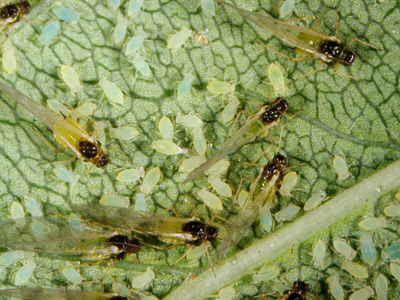Pest & Crop Newsletter, Entomology Extension, Purdue University
2009 Pest&Crop Reader Survey - Only your input can help us improve this publication! We would appreciate you taking a few moments to answer some questions concerning the Pest&Crop Newsletter. The following survey is voluntary and anonymous. All information collected is confidential and no hidden tracking of individual responses is being used. Click here to begin the survey.
Soybean Aphid Migration to Winter Host: Started Strong But Ended Weak – (Christian Krupke)
- The unprecedented fall swarms of winged aphids seen over much of Indiana and the Midwest may not result in high overwintering numbers.
- They were all in search of an overwintering host, and the vast majority did not find it.
You may recall, the soybean aphid has a complicated lifecycle that includes 2 host plants. In the fall, as soybeans begin to die, soybean aphids seek an overwintering host (buckthorn, genus name Rhamnus) to mate and lay eggs upon. These eggs hatch in spring, feed on buckthorn in April and May, and then develop a winged form that flies in search of soybeans. Soybeans are the host throughout the summer months and the cycle repeats itself in the fall with a flight back to buckthorn – by both male AND female aphids. The females then produce wingless egg-laying daughters. These will mate with the winged males and then lay the eggs that overwinter. The question on many producers’ minds was: will these unprecedented large swarms result in large egg numbers in fall, and therefore large spring populations on young soybeans?
During October of this year, I took a couple of trips through Indiana, Ohio and Michigan to evaluate aphid numbers and egg deposition on buckthorn. Dr. David Voegtlin of the Illinois Natural History Survey was my guide to these sites – areas where there are large clusters of buckthorn and that are historically good indications of egg numbers going into overwintering. These sites were scouted over the last 10 years or so by Dr. Voegtlin and the late Dr. Bob O’Neil, a biocontrol expert here at Purdue. Contrary to what many believe, buckthorn is not very common in Indiana and surrounding areas - the aphids find it using a combination of visual and odor cues, but for us it’s significantly more difficult. However, thanks to Dave and Bob we had a good range of sites to search this fall.
Newly birthed (wingless) females waiting for winged males for mating
The first visit, during October 18-19 made it obvious to us that the huge early fall migration did not result in an equivalent number of overwintering eggs. We found many female, wingless aphids (the egg-layers), in which many buckthorn leaves were absolutely covered with them. However, eggs were scarce. A primary reason for this may have been a scarcity of males. Unlike in the summer, when female soybean aphids produce clones – without mating, they need males in the fall to fertilize the overwintering eggs. The winged males originate on soybeans, fly to buckthorn, and then mate with the wingless egg-layers (the daughters of their winged sisters). In all our trips, to 7 sites in 3 states we did not see a single male. This was unexpected and unprecedented. A follow-up visit to IN locations on the 29th of October (after several warm days) revealed much the same thing – even fewer aphids and very few eggs.
Diseased winged soybean aphids
Why no males? One clue may have been that we saw many dead winged aphids, killed by fungal pathogens. We have seen these pathogens before - they often occur when aphids are in high densities and are a natural biological control. Unfortunately, the outbreaks are unpredictable and inconsistent, so we can’t rely on this during the growing season. However, it appears the winged aphids (including males) were heavily impacted by this pathogen and may not have survived long enough to mate with most of the egg-laying females.
What does this mean for spring of 2010? With no males observed and no green soybeans remaining for them to develop on, the chances of having many fertilized eggs seems very low. We expect low numbers of aphids on buckthorn in the spring, and relatively low spring populations on soybeans. This is good news for producers this coming spring. We will confirm with a spring (April 2010) visit to the buckthorn sites to see how the eggs did and post an update then.
Migrating soybean aphids on Iowa State campus this fall (Photo Credit: Logan Gaedke)
However, with the reproductive potential of this pest once they occupy soybean fields, later summer could be a completely different story. Especially if soybean aphid populations build in the northern Midwest states and move our way en masse during storm fronts. But the good news is that the coast looks to be clear for early spring.
2010 Crop Management Workshops
Warsaw
Monday, January 25, 2010
Grace College Campus
Rodeheaver Auditorium
Warsaw, IN
Alexandria
Tuesday, January 26, 2010
Madison County 4-H Fairgrounds
Farm Bureau Building
Alexandria, IN
Columbus
Wednesday, January 27, 2010
Elks Lodge
Columbus, IN
Ferdinand
Thursday, January 28, 2010
Ferdinand Community Center
Ferdinand, IN
West Lafayette
Friday, January 29, 2010
Beck Agricultural Center
Agronomy Center for Research and Education
4540 US 52 West
West Lafayette, IN 47906
Topics (Times are Eastern Time)
9:00-9:50 - What Do The New Federal Container and
Containment Rules Mean To Me?
Joe Becovitz
9:50-10:40 - Kill The Weeds…If You Can
Bill Johnson
10:40-11:00 - Break
11:00-11:30 - Challenging Insects and Changing Traits
Christian Krupke
11:30-12:00 - Soybean and Corn Nematodes
Jamal Faghihi
12:00-12:45 - Lunch Provided
12:45-1:35 - What Really Goes On After Sex in the Corn Field
Bob Nielsen
1:35-2:25 - Revisiting Soybean Management
Shaun Casteel
2:25-2:40 - Break
2:40-3:30 - Yield Robbers: Disease Bandits Strike Again
Kiersten Wise
3:30-4:20 - The Impact of Water Quality on Pesticide Performance
Fred Whitford
4:20-4:30 - CCH/CEU Forms
Credits: Certification credits for Indiana’s commercial (CCH) and private (PARP) pesticide applicators and Certified Crop Advisors (CEU) will be awarded to attendees. Credits for Ohio applicators have been requested.
Registration Information:
On line registration will SOON be available at:
<http://www.cont.purdue.edu/crop>





